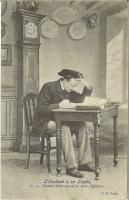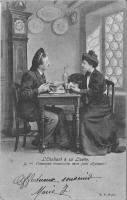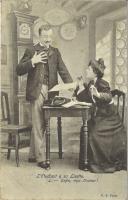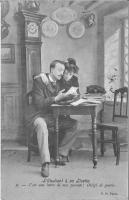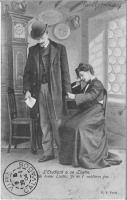This serie is composed by 6 postcards, printed by the publishing house V. Porcher from Paris. It is titled « The Student and his Lisette » and could be an Eugene Atget's work, one of the Forefather of Modern Photography, who worked for this publishing house late XIXth century. This postcards have been launched on the market on January 1904, for its first printing. The shot itself should be a little older, but it might not be older than 1890. It is more likely they was made few months before they were sold, in 1903.
Those shots stages a young man, alongside a young woman, studying. The scenery is sober : except a Franche-Comté's clock and some knick-knack hanging on the wall, only a table, a chair and a figured window. After having studied for a long time, he gots his doctorate. As a later time, he received a letter from his parents, and bids farewell to his good friend. It is likely the scene takes place in the young womans's appartment.
The first name Lisette is the diminutive form of Louise. « Lisette, Bernerette, Rigolette, Musette, Nanette are all grisettes who where heroines of songs or novels, often romantic ones [in the middle of the XIXth century.]» explains Henri Monnier. We can add to the list Jeanneton or even Huguette which are well known by the french students. By the way, it exists a version of the well-known song « La petite Huguette » called « La petite Lisette ».
In Paris and other Metropolitan areas, those grisettes are young girls who are financially independant because of their work as dressmaker, milliner or chairwoman, and they are in control of their sex life. it is then naturally they bound theirselves alongside men who share this three traits : the students, whose familly often live far away. This phenomenon is so usual that some of the dictionnary of the middle of the XIXth century will describe the "student girl" as the student boy partner, and they make it a synonym of grisette. If they are considered as libertines or prostitutes at this time, they become in 1903 one of the figures of the Belle Epoque Paris, so much that for some authors, their financial independance and their sexual freedom made them one of the foremother of feminism.
In his novel « Miss Mimi Pinson », written in 1845, Alfred de Musset tells the story of one of them, and makes his heroine sing those lines :
The med students, evening and morning
Ruin the sleeves of their vests,
Landerirette !
At her counter.
Although whitout abusing anybody
Mimi lectures them better
Than in the Sorbonne.
It must not be crumpled,
Mimi Pinson's robe.
We can deduct Mimi, Lisette, or even Huguette to be close of the universities' facilities and wildlife. They play with the student who support them partially the role of a temporary spouse. like the third picture suggests it « How do you find my breakfast ? ». The Student's favor for Lisette is only temporary and she knows it. In the next shot, we can see a change in the dynamic of their optic : He is pleased to graduate while she appears frightened as if the moment to walk a road further away from each other has finally come to be. « Finally Doctor », he is going to marry in his social classand find a job : « A letter from my parents. Mandated to leave ». Even if he leaves her, his feelings for are real : « My fair Lisette, I will never forget you ». And it was a common practive for the Students to advise their Lisette to the good care of their freind in hope they will live a happy life.
We have also to point the presence of a Flat on the 4 first pictures. Existing from the end of the 1880's, this unnamed hat called at this time simply "the beret", is only 15 years old when this postcards are pubblished. However, it is already implanted in the french iconography and from 1889, artists like Jean Béraud, a specialist of the parisian way of life, present the student wearing their beret. In 1903, the Flat is already known and recognized as one of the student's attribute. It is then naturally he wears it during the first part of the serie. At this time, he is studying at the University. But on the fourth picture, it falls in a symbollic manner from his head, to the table, when he gradutes before vanishing gradually from the two last ones.
Finally, Flate and Lisette share the same fate ; both are there only during the study time. While the Doctor is starting to work he leaves his Flate for the middle-class hat, just as Lisette has to move aside in order to let him find the woman who will share his lfe.
Sources : Wikipédia (Grisette, Carte Postale, Eugène Atget) – Henry Monnier, Les Grisettes, Paris, Bibliothèque nationale de France, Smith Lesouef, R-3217, pl. 6 – Journal Officiel du 30/11/1903 – Agnès Giard, Blog des 400 culs, Libération, La grisette, ancêtre des féministes ? – Jean Béraud, Brasserie d’étudiants (1889) – Xavier Hubaut, Chansons paillardes de France et d’ailleurs
Remerciements : Commandant RoSWeLL, Pierre Blaignon-Perbet and Céline GM for their relecture and their constructive comments.




